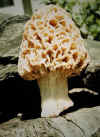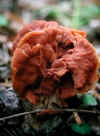| 5-02-05
Having watched spring morel seasons come and go in central Indiana for
more than 50 years, I would have to declare this springís season the strangest
of them all.
As we all know, the spring morel season is closely tied to weather conditions--especially
air temperatures and moisture in the earth. We observed a good illustration
of this point last spring when temperatures were right but the earth was
very dry in mid-April when the early wildflower bloom told us little black
and gray mushrooms were up. The little blacks and grays werenít there probably
because of a lack of moisture in the earth. Bad conditions turned to worse
when rains came and temperatures dropped when the late mushrooms, larger
grays and big yellow morels, were due early in May.
Two weeks ago when the early bloom of wildflowers hit, there was adequate
moisture in the woodlands and temperatures were right for little blacks
and grays. But they didnít show, and it was getting dry in the woodlands
when the big rains came throughout most of the state on April 22-23.
Dyed-in-the-wool mushroom hunters, including yours truly, saw
those rains as a reliable cue for the grand entrance of little grays and
blacks. The rains did, indeed, bring up morels--big yellows (yallers),
the one with the large, wrinkled stem.
This, of course, told me that the season for little grays and blacks
had slipped by, a sad but true conclusion. But last week, in the face of
those cold nights, little grays made their late-but-welcome debut (still
no blacks, though, and only a few spearheads). As the week progressed the
grays became larger, but still a far cry from a normal mushroom spring.
A strange set of mushroom-hunting circumstances, to say the least. And
now we can only wonder if the big yallers will join the circus when projected
warmer day/night temperatures come this weekend (May 7 - 8). I, for one,
will not be surprised--whatever the outcome.
Perhaps these earlier goings-on were foretold by the absence of yet
another spring fungi . . . Dryadís Saddle (Polyporus squamosus),
usually found on the sides of dead trees. This shelf mushroom was
showing up in modest size last weekend, but it has been conspicuous by
its absence in the early part of the mushroom season.
Incidentally, our morel safaris last weekend also brought the find of
our first sighting of the barn-red false morel (Gyromitra gigas).
Folks who are not real familiar with fungi become more than somewhat alarmed
at the prospects of someone mistaking the false morel (said to be
poisonous), for the edible morels, but there is no way a member of
the false morel clan can be mistaken for a member of our beloved morel
family.
Click
on thubnail image for enlarged view.

|
This
true morel, a darling of mycologists in Indiana, could never be confused
with the false morel. |

|
False
morels, said to be poisonous, do not look like true morels in any way. |
SENIOR LICENSE FAILS--Provisions
of House Bill (HB) 1765 that would have set up an inexpensive fishing license
for Hoosiers 60 years old and older were removed last week in the Indiana
General Assembly.
This is the fourth consecutive year the matter has failed, and it could
be the death knell of efforts to establish a license for seniors to bring
additional federal funding to the Division of Fish and Wildlife for fisheries
programs.
The rationale for creating an inexpensive license for seniors revolves
around the fact that federal funding for fisheries programs are pro rated
on the number of fishing licenses sold by each state. Because Hoosier seniors
fish free--without a license--our state fisheries agency receives somewhere
between $600,000 and $800,000 per year less than it would receive if seniors
were required to buy a fishing license.
|

